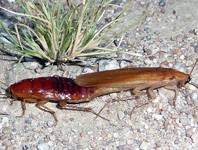Abstract
Soyka (1946) described the European fairyfly species Anagrus bakkendorfi Soyka (Hymenoptera: Mymaridae) from a single female collected on the same day, 7.x.1931, together with several non-type specimens incorrectly labeled as paratypes (Chiappini & Triapitsyn 1999), on a window at its type locality, the former St. Ignatius Jesuit College in Valkenburg, Limburg, the Netherlands. Soyka (1956) did not mention type specimens of any of his species of Anagrus Haliday. He described Anagrus avalae Soyka (Soyka 1956) based apparently on a specimen collected on Mt. Avala, Belgrade, Serbia, former Yugoslavia, along with several other nominal species (some also from Valkenburg) that were later synonymized with A. avalae and A. bakkendorfi by Chiappini (1989) and Chiappini & Triapitsyn (1999). The only, minor, morphological difference between the two nominal species is the length of the ovipositor in females relative to the length of the protibia, being at least 2.6× in A. bakkendorfi and at most 2.3× in A. avalae (Triapitsyn 2015). Specimens identifiable as both species were captured by the second author in 2000 by a Malaise trap in Iratibizkar, Irati Forest (Selva de Irati), Navarra, Spain. Chiappini & Triapitsyn (1999) discussed both nominal species but despite recognizing their apparent conspecificity, no formal synonymy was proposed. Triapitsyn & Berezovskiy (2004) and Triapitsyn (2015) also did not propose synonymy because at that time genetic evidence for conspecificity was lacking. However, Triapitsyn et al. (2019) obtained DNA and sequenced selected mitochondrial and nuclear ribosomal gene regions (COI and ITS2) from a specimen unambiguously identified by the first author as A. avalae that was collected in Sevenoaks, Kent County, England, United Kingdom. Because of this we decided to collect fresh specimens identifiable as A. bakkendorfi for molecular analysis and genetic comparison with those identifiable as A. avalae. Based on the previous record (Triapitsyn 2015), several females of A. bakkendorfi were successfully captured by the second author on 4.ix.2020 in Irati Forest, preserved in ethanol, and shipped to the first and third authors for morphological and molecular identification, respectively.
References
Altschul, S.F., Gish, W., Miller, W., Myers, E.W. & Lipman, D.J. (1990) Basic local alignment search tool. Journal of Molecular Biology, 215 (3), 403–410.
https://doi.org/10.1016/S0022-2836(05)80360-2
Boţoc, M. (1963 [1962]) Noi contribuţii la studiul calcidoidelor di R.P.R. (VIII). Studia Universitatis Babeş-Bolyai, Series Biologia, 1, 95–109. [in Romanian]
Burks, B.D. (1979) Family Mymaridae. In: Krombein, K.V., Hurd, P.D. Jr., Smith, D.R. & Burks, B.D. (Eds.), Catalog of Hymenoptera in America North of Mexico. Vol. 1. Smithsonian Institution Press, Washington, pp. 1022–1033.
Chiappini, E. (1989) Review of the European species of the genus Anagrus Haliday (Hymenoptera Chalcidoidea). Bollettino di Zoologia agraria e di Bachicoltura, Serie II, 21, 85–119.
Chiappini, E. & Triapitsyn, S.V. (1999 [1997]) Redescription of Anagrus avalae Soyka (Hymenoptera: Mymaridae), with new synonymies. Frustula Entomologica nuova serie, 20 (33), 119–126.
Chiappini, E., Triapitsyn, S.V. & Donev, A. (1996) Key to the Holarctic species of Anagrus Haliday (Hymenoptera Mymaridae) with a review of the Nearctic and Palearctic (other than European) species and descriptions of new taxa. Journal of Natural History, 30 (4), 551–595.
https://doi.org/10.1080/00222939600770301
Girault, A.A. (1915) Some new chalcidoid Hymenoptera from North and South America. Annals of the Entomological Society of America, 8 (3), 272–284.
https://doi.org/10.1093/aesa/8.3.272
Guilleminot, R.A. & Apablaza, J.U. (1986) Insectos y arácnidos asociados a la frambuesa (Rubus idaeus) en la Región Metropolitana, Chile. Insects and arachnids associated to raspberry (Rubus idaeus) in the Metropolitan Region, Chile. Ciencia e Investigación Agraria, 13 (3), 251–256.
https://doi.org/10.7764/rcia.v13i3.765
Huber, J.T. (2015) World reclassification of the Gonatocerus group of genera (Hymenoptera: Mymaridae). Zootaxa, 3967 (1), 1–184.
https://doi.org/10.11646/zootaxa.3967.1.1
Katoh, K. & Standley, D.M. (2013) MAFFT multiple sequence alignment software version 7: improvements in performance and usability. Molecular Biology and Evolution, 30 (4), 772–780.
https://doi.org/10.1093/molbev/mst010
Smits van Burgst, C.A.L. (1914) Een klein sluipwespje, Litus nigriceps n. sp. Entomologische Berichten, 4 (80), 125–127.
Soyka, W. (1946) Revision einiger Mymridengattungen [sic]. Zentralblatt für das Gesamtgebiet der Entomologie, 1 (2), 33–44.
Soyka, W. (1956 [1955]) Überblick über das Genus Anagrus Haliday (Alaptidae-Mymaridae, Chalcidoidea, Hymenoptera). Entomologisches Nachrichtenblatt Österreichischer und Schweizer Entomologen, 7 (2), 23–26.
Triapitsyn, S.V. (2001) Review of the Australasian species of Anagrus (Hymenoptera Mymaridae). Belgian Journal of Entomology, 3 (2), 267–289.
Triapitsyn, S.V. (2015) Taxonomy of the genus Anagrus Haliday (Hymenoptera: Mymaridae) of the world: an annotated key to the described species, discussion of the remaining problems, and a checklist. Acta Zoológica Lilloana, 59 (1–2), 3–50.
Triapitsyn, S.V., Adachi-Hagimori, T., Rugman-Jones, P.F., Kado, N., Sawamura, N. & Narai, Y. (2020a) Egg parasitoids of Arboridia apicalis (Nawa, 1913) (Hemiptera, Cicadellidae), a leafhopper pest of grapevines in Japan, with description of a new species of Anagrus Haliday, 1833 (Hymenoptera, Mymaridae). ZooKeys, 945, 129–152.
https://doi.org/10.3897/zookeys.945.51865
Triapitsyn, S.V. & Berezovskiy, V.V. (2004) Review of the genus Anagrus Haliday, 1833 (Hymenoptera: Mymaridae) in Russia, with notes on some extralimital species. Far Eastern Entomologist, 139, 1–36.
Triapitsyn, S.V., Koponen, M., Vikberg, V. & Várkonyi, G. (2020b) Taxonomy, annotated new records and a checklist of Mymaridae (Hymenoptera) of Finland, with description of a new species of Eustochus. Acta Entomologica Musei Nationalis Pragae, 60 (2), 565–589.
https://doi.org/10.37520/aemnp.2020.039
Triapitsyn, S.V., Rugman-Jones, P.F., Tretiakov, P.S., Daane, K.M. & Wilson, H. (2020c) Reassessment of molecular and morphological variation within the Anagrus atomus species complex (Hymenoptera: Mymaridae): egg parasitoids of leafhoppers (Hemiptera: Cicadellidae) in Europe and North America. Journal of Natural History, 54 (27–28), 1735–1758.
https://doi.org/10.1080/00222933.2020.1827073
Triapitsyn, S.V., Rugman-Jones, P.F., Tretiakov, P.S., Luft Albarracin, E., Moya-Raygoza, G. & Querino, R.B. (2019) Molecular, morphological, and biological differentiation between Anagrus virlai sp. n., an egg parasitoid of the corn leafhopper Dalbulus maidis (Hemiptera: Cicadellidae) in the New World, and Anagrus incarnatus from the Palaearctic region (Hymenoptera: Mymaridae). Neotropical Entomology, 48 (1), 87–97.
https://doi.org/10.1007/s13744-018-0606-7
Truett, G.E., Heeger, P., Mynatt, R.L., Truett, A.A., Walker, J.A. & Warman, M.L. (2000) Preparation of PCR-quality mouse genomic DNA with hot sodium hydroxide and tris (HotSHOT). BioTechniques, 29 (1), 52–54.
https://doi.org/10.2144/00291bm09


